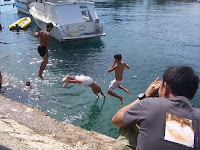Silot Bay is the most enchanting part of Liloan where many lives – past and present -- thrive. A shallow tidal lagoon, with mangrove swamps, fishponds and two islets, Silot Bay is all over in the heart of Liloan. Silot Bay is vital to both livelihood and recreational purposes of Liloanons.

The bay is connected to a channel that is abundant with sea urchins, a huge area of mudflat where locals gather seashells during low tides, and a productive fishing ground. It is also a feeding area for herons, egrets and other birds. During weekends and holidays, Liloanons from as far as the mountain barangays go to the bay to have a swim. The more daring ones have the option to dive from the concrete bridge (it used to be made of wood) down to the whirling waters called lilo.

The soothing atmosphere of Silot Bay, ironic considering the presence of whirlpools in the mouth of the bay, has rendered many a lives to find inner peace and respite during gracious sunrises and sunsets. (It is not saying though that there were no “troubled” lives lost who felt the troubles were worth a dive from the bridge.)
Silot Bay is also the cradle of all stories, myths, legends, folklores or whatever you call it. If you believe any of them, it is where Liloan has begun. Liloan’s own Garden of Eden.
One story, which I previously related in more details
here, tells that long time ago a defiant couple found refuge for their love near Silot Bay. There is abundance of fish so good for business. And indeed they did make business from their catch, although no coins yet then, by bartering it to nearby villages. When people asked them where the heck did they get it, the lovers would say “sa may lilo” (near the whirlpools). And thus born the name “Liloan”. The current location of Balay Pilapil is widely believed as the probable site of where the couple used to live.
Another version of that same story and couple has a more violent ending. After their defiance, the couple were cursed and punished or something like that by their family and community. One native Liloanon told us that the couple were thrown to the sea and died instantly. The whirlpools are said to be a reminder of their passionate love, defying all odds. And thus born the name of the bay “Silot,” a Cebuano word for punishment.

Another story is more Disney-like. Once upon a time in Liloan, mermaids were very friendly to humans. In fact, they mingled, played or even dined with people on some occasions. The mermaids possessed of bejeweled utensils, perhaps made of pearls, and they were kind enough to lend some of them to their friends. Lured by material wealth, some humans did not return their borrowed plates. The mermaids politely pleaded for the return of the plates but found no ear. This caused the anger of the mermaids, who unbeknownst to humans were more vicious in wrath than any other creatures. The mermaids left the place of “human interaction” but not without causing great tidal waves. The whole community near the sea got wiped out. The whirlpools remain to this day as ripples of those great waves.
Yet another story is fantastic to people’s standards. Liloan used to be a home of black fairies or “
dili ingun nato” (not like us). Human settlements caused them to retreat somewhere else. (The bloggers don’t know their exact location as of press time.) In retaliation to their forced eviction, them wicked
dili ingun nato would claim at least a life each year. Some well-meaning residents reported to us that there has never been a year without a missing bather who would get mysteriously lost even during calm waters. Some days later, the lost soul would float lifeless somewhere far. The residents would then just sigh and resign to the thought that the sea claimed that poor life.
And the final story that we were able to gather tells that Silot Bay is haven to one primordial, giant fish called cogtong (we don’t know if the specie actually existed ever in history). It is so huge that it could swallow at least three people in one instance. The cogtong could have its nest in the underwater cave (there’s a real amphibious cave in Liloan, yes) which traces all the way to the altar of
Liloan Church. The same modus operandi with them
dili ingun nato: the cogtong would swallow at least a human body each year. The twist is that with the cogtong, the poor human body would never be found again.

Scared yet? No, these are just stories. The bloggers will find it for themselves first if any of these were true and post about it here (that is, if one of us would come out alive during encounter). But, I tell you the actual view around the whole expanse of Silot Bay is breath-taking. And once you’re in the bridge, it is so nice to jump straight to the whirlpools. With my girlfriend’s permission and watch, I will jump from there one of these days. I don’t know with Immortalundead. ;-)
-Swerver-































































